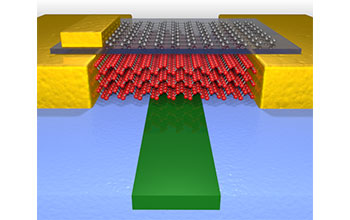

Courtesy : National Science Foundation This illustration shows a high performance photodetector, which uses few layers of black phosphorus (red atoms) to sense light in a waveguide (green material). Graphene (gray atoms) is also used to tune the performance.
Phosphorus, a highly reactive element commonly found in match heads, tracer bullets, and fertilizers, can be turned into a stable crystalline form known as black phosphorus. In a study by the University of Minnesota (U of M), researchers used an ultrathin black phosphorus film--only 20 layers of atoms--to demonstrate high-speed data communication on nanoscale optical circuits. The devices showed vast improvement in efficiency over comparable devices using the earlier "wonder material" graphene.
The existence of black phosphorus has been known for more than a century, but only in the past year has its potential as a semiconductor been realized. Because of unique properties, black phosphorus can be used to detect light very effectively, making it desirable for optical applications. The U of M team created intricate optical circuits in silicon, then laid thin flakes of black phosphorus over these structures using facilities at U of M's Nano Center.
The team also showed that the devices could be used for real-world applications by sending high-speed optical data over fibers and recovering it using the black phosphorus photodetectors. The group demonstrated data speeds up to three billion bits per second, which is equivalent to downloading a typical HD movie in about 30 seconds.
"Black phosphorus is an extremely versatile material," said Professor Steven Koester, who contributed to the project. "It makes great transistors and photodetectors, and has the potential for light emission and other novel devices, making it an ideal platform for a new type of adaptable electronics technology."
Funded in part by the National Science Foundatioin (grant ECCS 13-51002). To learn more, see the U of M Discover story Black phosphorus is new wonder material for improving optical communication. (Date of Image: March 2015) Credit: University of Minnesota General Restrictions:
Images and other media in the National Science Foundation Multimedia Gallery are available for use in print and electronic material by NSF employees, members of the media, university staff, teachers and the general public. All media in the gallery are intended for personal, educational and nonprofit/non-commercial use only.
Images credited to the National Science Foundation, a federal agency, are in the public domain. The images were created by employees of the United States Government as part of their official duties or prepared by contractors as "works for hire" for NSF. You may freely use NSF-credited images and, at your discretion, credit NSF with a "Courtesy: National Science Foundation" notation. Additional information about general usage can be found in Conditions. source : nsf.gov |

Nenhum comentário:
Postar um comentário
Observação: somente um membro deste blog pode postar um comentário.